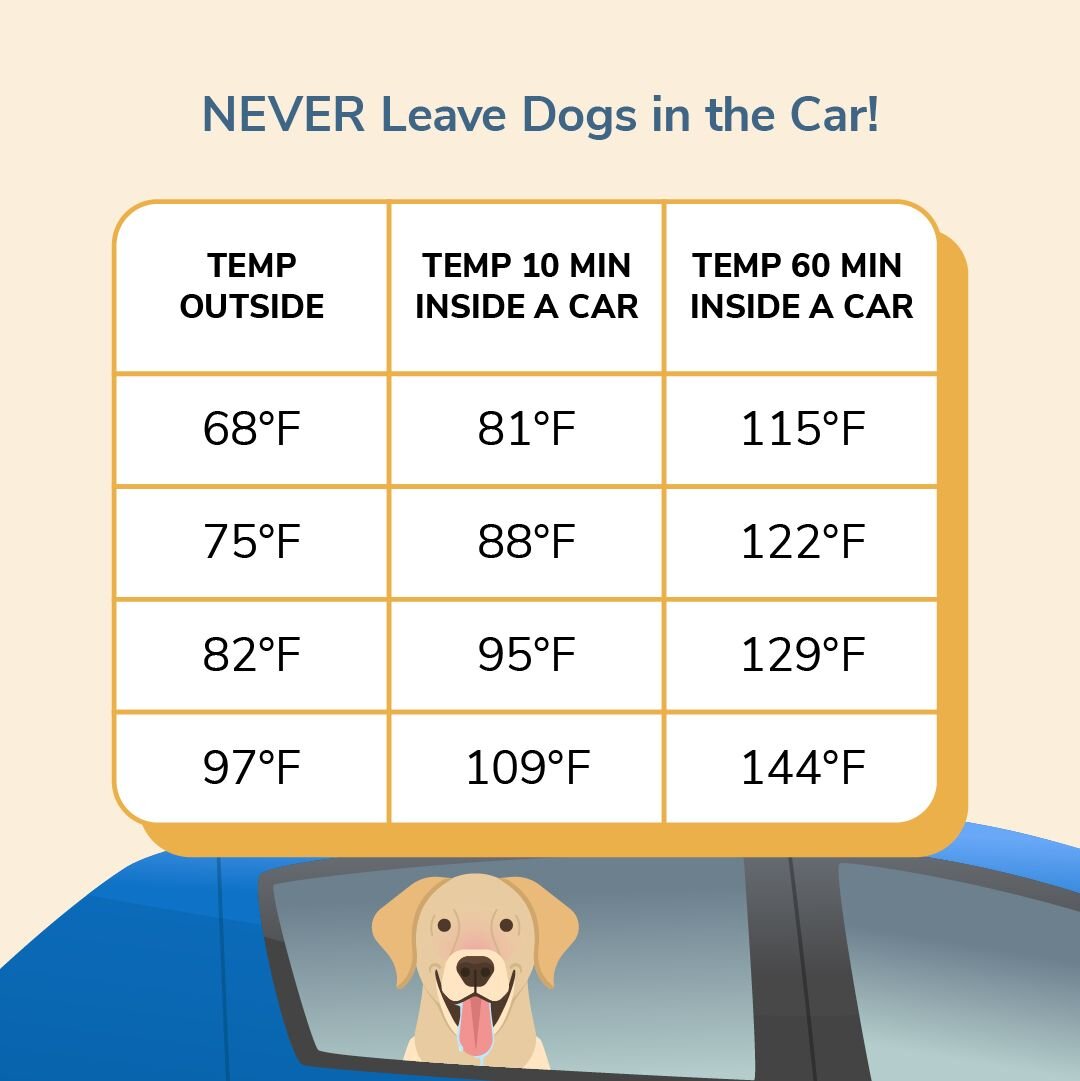7 Key Signs of Heat Stroke in Dogs (& How to Prevent Them)
It gets incredibly hot during these summer months, and it can be easy to sometimes forget that dogs overheat just like we do. Heat stroke in dogs can be life-threatening if undetected, but how can we tell the difference between a dog having fun in the sun and one who is starting to overheat?
To help, we’re going to break down the signs of heat stroke in dogs and provide pet parents with essential safety tips. Be sure to read through the entire post to learn how to prevent heat stroke in dogs and understand which breeds are more prone to overheating.
Table of Contents
Heat Stroke vs. Heat Exhaustion in Dogs
Heat stroke is the common term for hyperthermia, a condition that occurs when a dog has an abnormally high temperature of 103 degrees Fahrenheit (°F) or greater.
Understanding the difference between heat exhaustion and heat stroke is crucial for timely intervention that could save your dog's life.
- Heat Exhaustion: Also known as heat stress, occurs when the body temperature is between 103°F and 105°F.
- Heat Stroke: The most severe form of hyperthermia, happening when the body temperature exceeds 106°F. At this point, the risk of permanent brain damage, multiple organ failure, or death becomes very high. Permanent damage or death occurs at critical temperatures around 107°F to 109°F.
Unfortunately, the mortality rate of heat stroke in dogs is estimated to be around 50%.1 Dogs naturally have a higher body temperature than humans, typically ranging from 99°F to 101°F in a resting state, making them more susceptible to rapid overheating.
The mortality rate of heat stroke in dogs is estimated to be around 50%.
What Causes Heat Stroke in Dogs?
Dogs can develop heat stroke due to several factors, with the primary causes including environmental heat and exercise:
- Being Left in a Car: The most common and dangerous situation. Even with windows slightly open, temperatures inside a car can rise to fatal levels within minutes.
- Excessive Exercise in Hot Weather: Dogs running or playing vigorously on hot days can quickly overheat, especially without access to water.
- High Humidity: This increases the risk of heat stroke significantly as it impedes the dog's ability to cool down through panting.
- Sudden Exposure to Hot Climates: Dogs unaccustomed to hot weather or who have just moved to a warmer area are at greater risk.
- Dehydration: Lack of adequate hydration makes it difficult for dogs to regulate their body temperature.
Humidity plays a crucial role in heat regulation. The additional moisture in the air makes it harder for dogs to cool themselves through panting. This is why dogs can develop severe heat stroke even in moderately warm but highly humid conditions.

What are the Signs of Heat Stroke in a Dog?
Recognizing the early signs of heat stroke can save your dog’s life. Dogs display several warning signs when they are overheating:2
- Heavy Panting and Rapid Breathing: Initial signs that your dog is too hot.
- Bright Red or Pale Gums and Tongue: Indicators of abnormal blood circulation due to overheating.
- Increased Heart Rate: An elevated pulse is common as the body tries to cope with the heat.
- Excessive Drooling: Often seen as a response to trying to cool down through evaporation.
- Lack of Coordination: Stumbling or weakness can occur as heat stroke progresses.
- Vomiting or Diarrhea: These can be severe symptoms indicating the body is under extreme stress.
- Collapse or Seizures: These are critical signs requiring immediate emergency attention.
More severe symptoms of heat stroke in dogs may occur with continued exposure to high temperatures, such as muscle tremors, seizures, or even loss of consciousness. It's essential to monitor your dog closely during hot weather and take immediate action if any of these signs are observed.
Long-Term Effects of Heat Stroke in Dogs
Even if a dog survives an episode of heat stroke, there can be lasting impacts on their health. Some of the long-term effects include:3
- Kidney Failure: Heat stroke can cause severe dehydration, leading to kidney damage or failure.
- Abnormal Blood Clotting: The body's response to extreme heat can affect its ability to clot blood normally.
- Changes in Blood Pressure: Both high and low blood pressure can result from damage to the cardiovascular system.
- Neurological Disorders: Permanent brain damage can lead to behavioral changes or chronic conditions like seizures.
These complications underline the importance of prompt and effective treatment. Immediate action can reduce the severity of these long-term effects.
How to Treat Heat Stroke in Dogs
When it comes to heat stroke, every second counts. Here are the immediate steps to take if you suspect your dog is overheating:
- Move to a Cooler Area: Immediately take your dog out of the sun and into a cooler, shaded place.
- Offer Cool Water: Provide your dog with cool (not ice-cold) water to drink. Avoid forcing them to drink if they are not interested.
- Wet Their Paws and Head: Use cool water to wet their paws and gently drizzle it over their head. This can help lower their body temperature.
- Use a Hose or Bathtub: If you're outside, gently hose them off with cool water. Indoors, you can use a bathtub or sink to wet them down.
- Apply a Cool Compress: Place a cool, damp cloth around their head and neck to help lower the body temperature.
- Encourage Swimming: If you’re near a safe body of water, allow them to take a dip, ensuring the water isn’t too cold or moving too fast.
If your dog’s symptoms do not improve or they exhibit severe reactions such as seizures or become unresponsive, it is crucial to get them to a veterinarian or animal hospital immediately . Time is of the essence, and professional care can be life-saving.

How to Prevent Dogs from Overheating
Preventing heat stroke is always better than having to treat it. Here are essential tips from the Humane Society to keep your dog cool and safe during hot weather:4
- Keep Dogs Indoors: On hot or humid days, limit your dog's time outdoors and ensure they have access to a cool, air-conditioned environment.
- Provide Ample Water: Always have fresh, cool water available for your dog to drink.
- Avoid Peak Heat Hours: Walk your dog early in the morning or late in the evening when temperatures are cooler.
- Never Leave Dogs in Cars: Even with the windows cracked, temperatures can rise rapidly inside a vehicle.
- Use Cooling Mats or Towels: Provide a cool mat or damp towel for your dog to lie on.
- Shade and Shelter: Make sure your dog has access to shaded areas when outside.
- Monitor Panting: Heavy panting is a sign that your dog is getting too hot. Bring them inside and provide water if they start panting excessively.
- Groom Appropriately: Trim long hair but avoid shaving your dog completely, as their fur helps protect against sunburn.
During the summer months, keeping your dog cool requires vigilance and proactive care. Be mindful of the environment and always prepare for outings with water and shade options.

Which Dog Breeds Are Prone to Heat Stroke?
Certain breeds are more susceptible to heat stroke due to their physical characteristics or coat type. Understanding these risks can help in better managing their exposure to heat.
- Brachycephalic Breeds: Dogs with short noses and flat, wide faces — such as French Bulldogs, Pugs, and Boxers — have more difficulty panting effectively, which hinders their ability to cool down.
- Thick-coated Breeds: Breeds like Siberian Huskies and Newfoundlands, with dense, full coats, can overheat quickly in hot weather.
- Overweight Dogs: Extra layers of fat act like insulation that impede the body's ability to cool itself down. According to one study, the rate of mortality due to heat stroke in dogs nearly tripled for obese pets.5
- High-energy Dogs: Puppies and very active breeds can tire quickly in the heat and are at greater risk of overheating.
- Older Dogs and Puppies: They often have less efficient temperature regulation and may have other health issues that increase their vulnerability.
If you own a pet that fits into one of these categories, take extra precautions to prevent your dog from overheating.
The mortality rate of heat stroke is about 3x higher in obese pets.
Key Concepts to Chew On
- Recognize Early Signs: Be vigilant about the symptoms of heat stroke, such as heavy panting and disorientation.
- Act Quickly: If your dog shows signs of overheating, move them to a cool area and start cooling measures immediately.
- Preventive Measures: Keep your dog indoors during extreme heat, provide plenty of water, and avoid strenuous activity in hot weather.
- Understand Breed Risks: Be aware of the specific needs and vulnerabilities of your dog’s breed concerning heat.
Summer can pose significant risks for dogs, but with careful monitoring and proactive measures, you can keep your furry friend safe and comfortable. Pawlicy Advisor is here to provide expert guidance when choosing a pet insurance safety net, ensuring peace of mind if any emergencies arise.
Some people can predict the future.
For everyone else, there's pet insurance.
Looking to save on vet bills? See which pet insurance is right for you.
Instant results. 1M+ pet parents served.
⭐⭐⭐⭐⭐ 4.9 stars across hundreds of reviews.
References
- Bellevue Animal Hospital, "How How is Too Hot?". Accessed June 18, 2024.
- American Kennel Club, "Heatstroke in Dogs". Accessed June 18, 2024.
- Memphis Veterinary Specialists, "How to Tell if Your Dog Has Heat Stroke". Accessed June 18, 2024.
-
Humane Society, "Keep Pets Heat Safe". Accessed June 18, 2024.
- Yaron Bruchim, Eyal Klement, Joseph Saragusty, Efrat Finkeilstein, Philip Kass, and Itamar Aroch, "Heat Stroke in Dogs: A Retrospective Study of 54 Cases" J Vet Intern Med 2006;20:38–46. Accessed June 18, 2024.
Do you want to find the best pet insurance?
Let's analyze your pet's breed, age, and location to find the right coverage and the best savings. Ready?
Analyze My PetAbout Pawlicy Advisor
The pet insurance marketplace endorsed by veterinarians, at Pawlicy Advisor we make buying the best pet insurance easier. By comparing personalized coverage and pricing differences we can save you a ton of money, up to 83% in some instances!
Instantly Compare Pet Insurance Plans
Guides
Determine If Pet Insurance Is Worth It
Comparison Charts
Find Your State
Dog Insurance
DVM
Ricky Walther, DVM, is a small animal general practitioner in the greater Sacramento, California area. Realizing the positive financial and medical impact that pet insurance can provide for pet parents and the profession, he lends support and advice to companies like Pawlicy Advisor "The Pet Insurance Marketplace") that simplify the process of connecting with veterinary financing resources.
